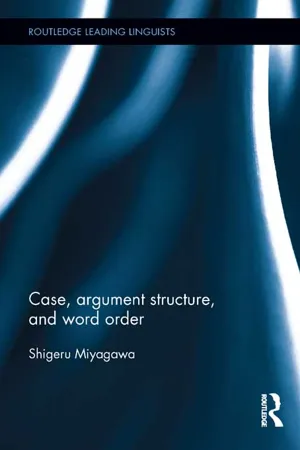
- 328 pages
- English
- ePUB (mobile friendly)
- Available on iOS & Android
Case, Argument Structure, and Word Order
About this book
Over the years, a major strand of Miyagawa's research has been to study how syntax, case marking, and argument structure interact. In particular, Miyagawa's work addresses the nature of the relationship between syntax and argument structure, and how case marking and other phenomena help to elucidate this relationship. In this collection of new and revised pieces, Miyagawa expands and develops new analyses for numeral quantifier stranding, ditransitive constructions, nominative/genitive alternation, "syntactic" analysis of lexical and syntactic causatives, and historical change in the accusative case marking from Old Japanese to Modern Japanese. All of these analyses demonstrate an intimate relation among case marking, argument structure, and word order.
Frequently asked questions
- Essential is ideal for learners and professionals who enjoy exploring a wide range of subjects. Access the Essential Library with 800,000+ trusted titles and best-sellers across business, personal growth, and the humanities. Includes unlimited reading time and Standard Read Aloud voice.
- Complete: Perfect for advanced learners and researchers needing full, unrestricted access. Unlock 1.4M+ books across hundreds of subjects, including academic and specialized titles. The Complete Plan also includes advanced features like Premium Read Aloud and Research Assistant.
Please note we cannot support devices running on iOS 13 and Android 7 or earlier. Learn more about using the app.
Information
1 Numeral quantifiers and thematic relations1
1 INTRODUCTION
teacher-NOM three-CL came
‘Three teachers came.’
Hanako-NOM book-ACC two-CL bought
‘Hanako bought two books.’
| (3) | 1. | dai | furniture, machines, land and air vehicles |
| 2. | hiki | animals [excluding birds, for some speakers] | |
| 3. | hon | long, slender objects, such as pencils, trees, threads, roads, and lines; (items that follow a trajectory, such as TV programs, letters, telephone calls, and baseball hits) | |
| 4. | kabu | rooted plants, roots and bulbs, shares of stock | |
| 5. | ken | buildings or parts of buildings that act in some functional capacity, such as a home or shop | |
| 6. | ken | incidents, occurrences, such as robberies, fires, and accidents | |
| 7. | ki | airplanes, (other air vehicles, such as helicopters and rockets) | |
| 8. | ko | small objects of roughly equivalent extension in all three dimensions, such as fruits, candies, and stones; also coins [general inanimate classifier, for some speakers] | |
| 9. | ku | haiku [seventeen-syllable poems], (other short poems) | |
| 10. | kyoku | pieces of music | |
| 11. | mai | flat, thin objects such as sheets of paper, pieces of cloth, dishes, items of clothing, phonograph records, leaves, rugs, and coins | |
| 12. | mei | human beings [honorific] | |
| 13. | mon | questions, problems | |
| 14. | mune | buildings | |
| 15. | nin | human beings | |
| 16. | satu | books, magazines, notebooks, books of tickets, pads of paper | |
| 17. | seki | large boats | |
| 18. | soku | pairs of footwear | |
| 19. | soo | small boats | |
| 20. | syoku | meals | |
| 21. | teki | drops of liquid | |
| 22. | ten | points in a score, items in an inventory, works of art | |
| 23. | too | large animals | |
| 24. | toori | methods, opinions | |
| 25. | tu | inanimates, concrete or abstract [general classifier] | |
| 26. | tubu | small, grainlike objects such as grains of rice, grapes, gems, pills, and drops of liquid | |
| 27. | tuu | letters and postcards, documents, (telephone calls) |
student-NOM book-ACC four-CL bought
‘The students bought four books.’
student-NOM book-ACC four-CL bought
student-NOM four-CL book-ACC bought
‘Four students bought books.’
student-NOM today three-CL came
‘Three students came today.’
book-ACC Taro-NOM two-CL bought
Lit. ‘Books, Taro bought two.’
Table of contents
- Cover
- Full Title
- Copyright
- Routledge Leading Linguists
- Dedication
- Table of Contents
- Introduction
- 1 Numeral quantifiers and thematic relations
- 2 Telicity, stranded numeral quantifiers, and quantifier scope
- 3 Argument structure and ditransitive verbs in Japanese
- 4 Nominalization and argument structure
- 5 Genitive subjects in Altaic and specification of phases
- 6 The genitive of dependent tense in Japanese and its correlation with the genitive of negation in Slavic
- 7 Blocking and Japanese causatives
- 8 Blocking and causatives revisited
- 9 Historical development of the accusative case marker
- 10 The Old Japanese accusative revisited
- Notes
- References
- Index